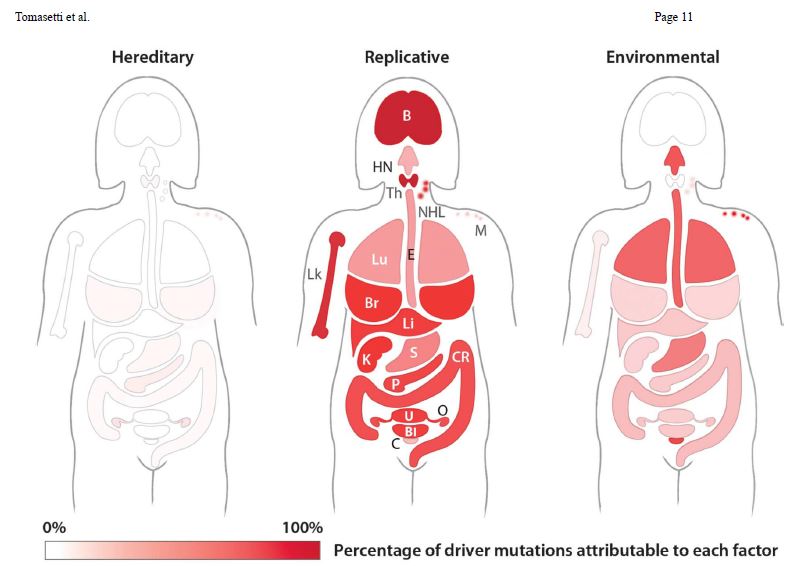This one is going to disappoint some of you. What causes cancer? The answer is – life. Cancer happens; well, most of the time!
Primary reasons for cancer in humans are classified into three categories: environmental (E), hereditary (H), and mistakes during DNA replications (R).
Researchers at Johns Hopkins University evaluated cancer incidence in 69 countries and found correlations between cancer risks and these factors. Before going into details, please see the picture that I copied from Tomasetti’s paper (Tomasetti et al., Science. 2017 March 24; 355(6331): 1330–1334. doi:10.1126/science.aaf9011.).

First, a primer on what I meant by the replication factor, R. Approximately three mutations occur every time a stem cell divides. Most of these are inconsequential to us, but occasionally, they cause trouble. What is so special about stem cells? Stem cells are the body’s prime cells that give birth to cells with specialized functions – the blood cells, brain cells, heart muscle cells or bone cells.
Leading environmental factors known to cause cancer in humans include UV from sunlight, tobacco, soot, asbestos, carcinogenic chemicals, and ionising radiation.
Randomness, Again
These results also partly explain the observed stochastic nature of the disease. Remember, “my granny had cancer without smoking, and my uncle still smoking healthy”, all that stuff! Now you know the reasons for the deadly outcome are many – some you know already, some don’t, and perhaps never will.
Not an Either Or
Results from the study also point to the human tendency to rush to wrong conclusions, similar to a deductive fallacy. Environmental reasons are responsible for some cancer types, but it does not mean all cancers are due to Environment. To be precise, two in three are not! Does it mean you ignore environmental factors, smoke, eat tobacco, and give up sunscreen? Quite the opposite. One must continue avoiding exposure to carcinogens as they are the levers to manage those individual probabilities that are within your control, which eventually leads to a reduction in the combined chances of getting the disease (remember the AND rule of probability?). You thus avoided the disease, at least for a while!
The last takeaway of the study, which showed Pearson’s linear correlation of 0.804 between total stem cell divisions and lifetime cancer risk, leads to an unwanted prize for achieving higher life expectancies – the more you live, the more your chance of dying of cancer!
Science. 2015 January 2; 347(6217): PubMed Link
Science. 2017 March 24; 355(6331): PubMed Link
Stem Cells: Mayo Clinic

